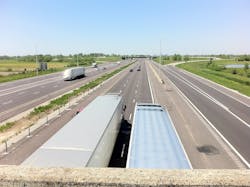Storm-water treatment does not effect tight working windows on I-64/I-255 interchange in East St. Louis
In most ways, the resurfacing of the I-64/I-255 interchange near East St. Louis, Ill., was an ordinary—albeit big—project; it’s a large cloverleaf intersection and extremely busy, but paving contractors Keeley & Sons Inc. are used to that. However, there was one unique feature; “Most years, we install maybe 10-15 catch-basin risers—for the whole year,” explained Project Engineer Bob Germann. “But on this project alone, we installed a total of 100 catch-basin risers.”
The catch basins lined a barrier wall that separated access ramps from main lanes, which meant that crews working on the basins would be exposed to traffic. This could have been a problem; as part of the contract, lane closures had to be kept to a minimum. “That’s pretty common around here.” said Germann, “On this project, we couldn’t close lanes at all during peak hours, from 6-9 a.m. westbound and 3-6 p.m. eastbound.”
Keeley use catch-basin risers and manhole risers from American Highway Products. The manhole risers were previously approved for use by the Illinois Department of Transportation, and the department approved the use of the catch-basin risers for the I-64 project.
“I’m really glad we had the risers available,” says Germann. “Without them, we would have been forced to hammer out the existing frames and pour new concrete; it could have taken a couple of weeks just on that part of the job.”
The catch-basin risers used on the job are custom-made for particular projects, and can be easily installed with hand tools—the entire process takes just a few minutes per riser. Keeley & Sons’ crews installed the risers after the binder course was laid, and before the final paving lift. Instead of a couple of weeks, all 100 catch basins were raised to grade in just two days.
Every project has its wrinkles and surprises. By looking for a better method, Keeley & Sons were able to smooth out a major obstacle and prevented a “catch” from turning into a big problem.
